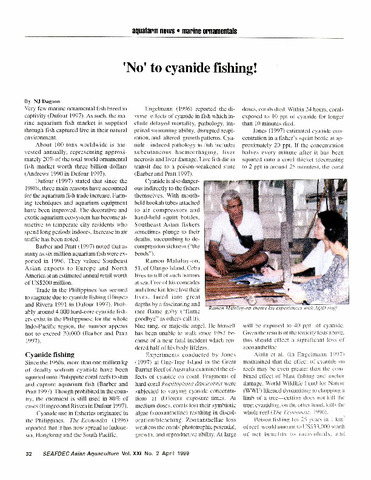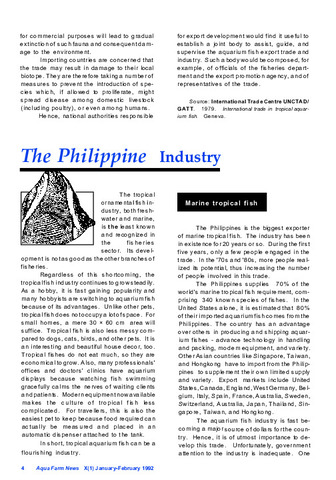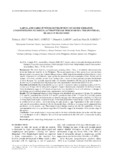'No' to cyanide fishing!
- Global styles
- MLA
- Vancouver
- Elsevier - Harvard
- APA
- Help

Date
1999Author
Page views
2,915ASFA keyword
zooxanthellae 
marine environment
biodiversity
nature conservation
coral reefs
cyanides
fish poisoning
fishery regulations
fishing
fishing barriers
food fish
lethal effects
livelihoods
marine fish
marketing
mortality
ornamental fishes
policies
resource management
stunting
sustainable fishing
toxicity tests
trade

marine environment

biodiversity

nature conservation

coral reefs

cyanides

fish poisoning

fishery regulations

fishing

fishing barriers

food fish

lethal effects

livelihoods

marine fish

marketing

mortality

ornamental fishes

policies

resource management

stunting

sustainable fishing

toxicity tests

trade

AGROVOC keyword
Metadata
Show full item recordShare
Suggested Citation
Dagoon, N. J. (1999). 'No' to cyanide fishing!. SEAFDEC Asian Aquaculture , 21(2), 32-33, 37-39. http://hdl.handle.net/10862/2756
Type
magazineArticleISSN
0115-4974Collections
Related items
Showing items related by title, author, creator and subject.
-
The Philippine industry: Marine tropical fish
Castaños, Milagros T.; Southeast Asian Fisheries Development Center, Aquaculture Department (Aquaculture Department, Southeast Asian Fisheries Development Center, 1992) -
CRM in the Philippines: Lessons learned
Southeast Asian Fisheries Development Center, Aquaculture Department (Aquaculture Department, Southeast Asian Fisheries Development Center, 1996)Philippine coastal communities can become capable fishery resource managers and that their management practices can become largely self-sustaining if the project approach focuses on assisting fishermen to learn how to help ... -
Larval and early juvenile development of silver therapon, Leiopotherapon plumbeus (Actinopterygii: Perciformes: Terapontidae), reared in mesocosms
Aya, Frolan ; Corpuz, Mark Nell C.; Laron, Manuel A.; Garcia, Luis Maria
; Corpuz, Mark Nell C.; Laron, Manuel A.; Garcia, Luis Maria  (Szczecińskie Towarzystwo Naukowe, 2017)
The silver therapon, Leiopotherapon plumbeus (Kner, 1864), is an endemic and economically important freshwater food fish in the Philippines. The natural populations of this species have been declining during the past years, ...
(Szczecińskie Towarzystwo Naukowe, 2017)
The silver therapon, Leiopotherapon plumbeus (Kner, 1864), is an endemic and economically important freshwater food fish in the Philippines. The natural populations of this species have been declining during the past years, ...




